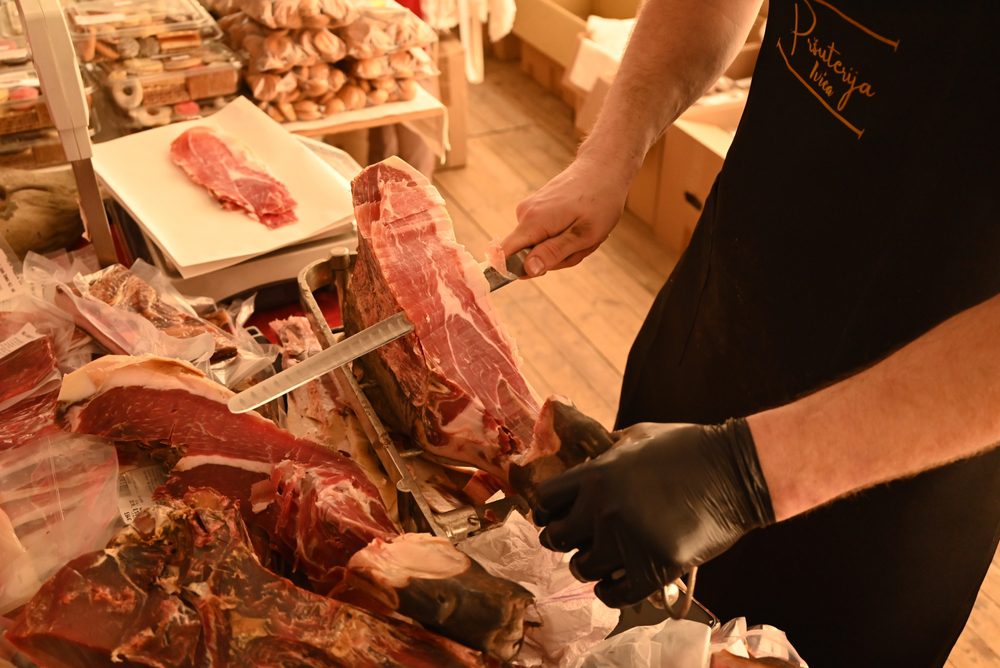Discover the secrets and nuances of this delicious Dalmatian delicacy that's changing the culinary world.

What is prosciutto? Just one of the most popular and beloved delicacies in the southern part of Europe, for sure! Croatian prosciuttos are celebrated both domestically and internationally for their exceptional quality and regional uniqueness. They are a testament to Croatia’s rich culinary heritage, with each area contributing its own special touch to this beloved delicacy. Whether you savor Krčki pršut, Istarski pršut, Dalmatinski pršut, or Drniški pršut, you’re experiencing a slice of Croatia’s diverse and delicious culinary tradition!
What is prosciutto?
For all those who haven’t discovered this delicacy yet, prosciutto is a premium ham made from the hind leg of a pig, traditionally prepared in southern European countries. The meat is dry-cured with a mixture of salt and various spices, then aged for an extended period, often over a year. This process results in a flavorful ham that is enjoyed as a delicacy in various Mediterranean and European cuisines. Prosciutto can be served as an appetizer, in sandwiches, or as a complement to various dishes, offering a savory and salty taste with a unique texture!
History of prosciutto in Dalmatia
The tradition of prosciutto in Dalmatia has ancient origins dating back to the time of the Roman Empire. The Romans employed a method involving salting, pressing, and air-drying to both preserve and enrich the flavor of ham, consequently introducing this process to the rest of Europe.
Once this technique found its way to the Dalmatian region, it became a closely guarded craft, passed down through generations. Over time, Dalmatian craftsmen refined and adapted the process, discovering the ideal conditions for aging, perfecting the salting method, experimenting with different types of salt, and determining optimal meat weight. This evolution culminated in the creation of the distinctive and cherished traditional product we know today!
Production process of Dalmatian prosciutto
The production of Dalmatian prosciutto is a meticulous, time-intensive process spanning approximately one year, comprising of multiple distinct phases.
Meat Preparation
Initially, the selection of a hind leg from a healthy pig, aged at least nine months, is paramount. This leg undergoes thorough washing and meticulous removal of any remaining meat or fat.
Salting
The fresh loin is subjected to a blend of salt, sugar, and spices for several weeks. This salting procedure serves a dual purpose — preserving the meat and enhancing its flavor. After the salting, the meat needs to be left to sit for 20 days.
Pressing
Following salting, the leg is pressed between plates, aligning them, and weight is applied. This pressing stage continues for 7 to 14 days at temperatures between +4°C to +6°C.
Drying and Smoking
Subsequently, the leg is subjected to natural drying and smoking conditions. The drying process extends over several months, while smoking is accomplished over the span of several days. The powerful Dalmatian wind, known as Bura, significantly contributes to the drying process by removing moisture from the prosciutto meat and imparting its distinctive flavor! Once the temperature of the salted and pressed legs is room temperature, the smoking phase starts, utilizing cold-smoke generators. Drying and smoking together last for a maximum of 45 days.
Maturation
Upon completing the drying and smoking phases, the leg matures in dark, cool chambers for several months. This maturation stage crucially refines the final flavor and texture of the prosciutto meat. Maturation happens within shaded chambers with gentle air circulation, ideally maintaining a temperature below +20°C and relative air humidity below 90%.
Differences and similarities among Croatian prosciuttos
A common thread among Croatian prosciuttos is the use of sea salt, sourced from either the Adriatic Sea or the Mediterranean. However, what truly sets these delicacies apart are the unique local climates and winds that influence their creation. Each region, from Dalmatia to Istria and beyond, imparts distinct characteristics to its prosciutto.
Dalmatian prosciutto
Dalmatian prosciutto hails from the Dalmatian region along Croatia’s coastline. Aged for 12 to 18 months, it boasts a robust flavor enriched with Mediterranean herbs and spices. What sets it apart is the influence of the unique Bura wind during the drying process, infusing it with distinctive qualities.
Krk prosciutto
Krk prosciutto originates from the enchanting island of Krk in the northern Adriatic Sea. With a minimum aging period of 12 months, it is celebrated for its delicate, slightly sweet flavor. Its unique character is shaped by the use of sea salt and natural drying methods, influenced by the island’s exceptional climate.
Istrian Prosciutto
Istrian Prosciutto is a treasure from the Istrian Peninsula in northwestern Croatia. Aged for 12 to 24 months, it reveals a captivating complexity, with flavors often described as mildly sweet, savory, and subtly nutty. Crafted using Istrian sea salt and naturally air-dried, its distinct character thrives thanks to the region’s unique microclimate.
Drniš prosciutto
Drniš prosciutto is proudly born in the picturesque town of Drniš, nestled in the Dalmatian hinterland. It matures for a minimum of 12 months, resulting in its signature intense, smoky flavor, complemented by subtle hints of Mediterranean herbs. Crafted through salting with sea salt and air-drying, this prosciutto’s character is shaped by the region’s continental climate.
How to cut and serve prosciutto

To cut prosciutto you will need a sharp, thin-bladed knife which ensures precise, tear-free slicing. Prior to cutting, let the prosciutto meat rest at room temperature for a few minutes — this softens the fat and enhances the flavor.
Placing thinly sliced prosciutto alongside Pag cheese is a delightful combination, with the salty, savory ham beautifully complementing the sweet nuances of the cheese. Additionally, consider adding fruits such as cantaloupe, figs, or pears to your platter — the juxtaposition of sweet and salty creates a symphony of flavors.
The choice of wine is crucial too! Opt for a dry white or red wine, or even sparkling wine, as it harmonizes with the prosciutto’s taste and adds to the overall culinary experience.
Producers whose prosciuttos carry the “Originally Croatian” label
In the world of prosciutto production, Italy, Spain, and France have long held the spotlight as leading producers. However, Croatian prosciutto has been gaining recognition for its distinctive flavor and traditional curing methods. The secret lies in the country’s unique climate, with coastal areas providing ideal conditions for air-drying the meat.
Croatian prosciutto producers take pride in their commitment to using only the finest cuts of pork and preserving time-honored techniques. The result is a tender, flavorful prosciutto that can easily compete with the best in Italy, Spain, and France. As Croatian pršut gains international recognition, it’s clear that it’s not lagging behind in terms of quality in the world of prosciutto production. If you are looking for some of the best prosciuttos, opt for those with Originally Croatian label, such as Studenački pršut by Gradina or Vrgorački pršut by Braća Pivac.
If you want to try some amazing dalmatian prosciuttos while on vacation, you can always do so in the Mali raj restaurant! Book your spot in Camping Village Šimuni today and treat yourself to the best of Croatian delicacies! Our mobile homes and pitches are ready to accommodate you, so book your dates now and experience beauty of Dalmatia first-hand!